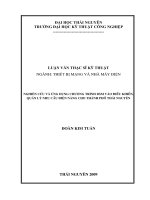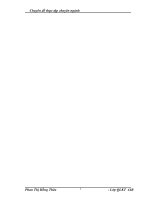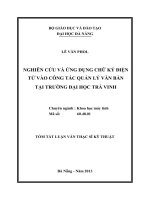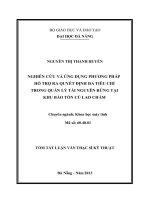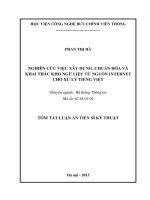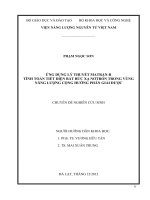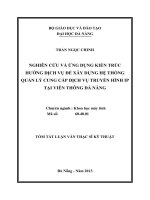Using mind mapping techniques to develop Ly Thuong Kiet high school 11th grade students’ reading text summary skills = Nghiên cứu việc ứng dụng biểu đồ tư duy đ
Bạn đang xem bản rút gọn của tài liệu. Xem và tải ngay bản đầy đủ của tài liệu tại đây (1.2 MB, 61 trang )
VIETNAM NATIONAL UNIVERSITY, HANOI
UNIVERSITY OF LANGUAGES AND INTERNATIONAL STUDIES
FACULTY OF POST-GRADUATE STUDIES
********************
PHẠM THỊ THÚY VÂN
USING MIND-MAPPING TECHNIQUES TO DEVELOP
LY THUONG KIET HIGH SCHOOL 11
TH
GRADE STUDENTS'
READING TEXT SUMMARY SKILLS
NGHIÊN CỨU VIỆC ỨNG DỤNG BIỂU ĐỒ TƯ DUY ĐỂ PHÁT
TRIỂN KỸ NĂNG TÓM TẮT BÀI ĐỌC CHO HỌC SINH LỚP 11
TRƯỜNG THPT LÝ THƯỜNG KIỆT
M.A MINOR THESIS
HANOI – 2012
Field: English Teaching Methodology
Code: 60.14.10
VIETNAM NATIONAL UNIVERSITY, HANOI
UNIVERSITY OF LANGUAGES AND INTERNATIONAL STUDIES
FACULTY OF POST-GRADUATE STUDIES
**********************
PHẠM THỊ THÚY VÂN
USING MIND-MAPPING TECHNIQUES TO DEVELOP
LY THUONG KIET HIGH SCHOOL 11
TH
GRADE STUDENTS'
READING TEXT SUMMARY SKILLS
NGHIÊN CỨU VIỆC ỨNG DỤNG BIỂU ĐỒ TƯ DUY ĐỂ PHÁT
TRIỂN KỸ NĂNG TÓM TẮT BÀI ĐỌC CHO HỌC SINH LỚP 11
TRƯỜNG THPT LÝ THƯỜNG KIỆT
M.A Minor Thesis
HANOI – 2012
Field: English Teaching Methodology
Code: 60.14.10
Supervisor: ĐỖ BÁ QUÝ, M.Ed.
iv
TABLE OF CONTENTS
List of abbreviations iv
List of figures and tables v
Part A: INTRODUCTION 1
1. Rationale of the study 1
2. Aims of the study 2
3. Research hypothesis and questions 2
4. Method of the study 2
5. Significance of the study 3
6. Scope of the study 3
7. Organization of the study 3
PART B: DEVELOPMENT 5
Chapter I: Literature review 5
1.1.
Reading and reading comprehension
5
1.1.1. Definition of Reading 5
1.1.2. Definitions of reading comprehension 5
1.1.3. The stages of a reading lesson 6
1.1.3.1. The pre- reading stage 6
1.1.3.2. The while- reading stage 7
1.1.3.3. The post- reading stage 7
1.2. Reading text Summary 9
1.2.1. Definition of a reading text summary 9
1.2.2. Steps to writing a reading text summary 9
1.2.3. Types of reading text summaries 10
1.2.3.1. Descriptive summary 10
1.2.3.2. Informative summary 10
v
1.2.3.3. Evaluative summary 11
1.3. Mind mapping 11
1.3.1. Definition of mind map 11
1.3.2. Steps to create a mind map 12
1.3.3. Definition of mind mapping techniques 13
1.3.4. The classification of mind mapping techniques 14
1.3.4.1. Network tree 14
1.3.4.2. Event chain 15
1.3.4.3. Cycle concept map 15
1.3.4.4. Spider concept map 16
1.3.5. Advantages and disadvantages of mind mapping techniques 17
1.3.5.1. Advantages of mind mapping techniques 17
1.3.5.2. Disadvantages of mind mapping techniques 17
1.3.6. Steps of summarizing the reading texts through mind mapping techniques 18
1.3.6.1. Skim 18.
1.3.6.2. Read 18
1.3.6.3. Mind Map 18
1.3.6.4. Study 18
1.3.6.5. Personalise 18
1.4. Related studies of mind mapping 19
1.5. Summary 19
Chapter II: The study 20
2.1. The context of the study 20
2.2. Participants 21
2.3. Rationale for using quasi-experiment 22
2.4. Experiment design 23
2.5. Research Variables 24
vi
2.5.1. Independent Variable 24
2.5.2. Dependent Variable 24
2.6. Data collection instruments and procedure 24
2.6.1. Data collection instruments 24
2.6.2. Data collection procedure 25
2.7. Data Analysis procedure 26
Chapter III: Data analysis and discussions 27
3.1. Data analysis 27
3.1.1. Tests 27
3.1.1.1. Comparison between pretest scores of experimental class and control class 27
3.1.1.2. Comparison between pretest and posttest scores of experimental class and control
class 28
3.1.1.3. Comparison between posttest scores of experimental class and control class 29
3.1.2. Questionnaires 30
3.2. Discussion 33
3.2.1 The effectiveness of mind mapping technique in developing students' reading
text summary skills at LTK high school 34
3.2.2 Students' attitudes towards using mind mapping techniques 34
3.3. Summary 34
PART C: Conclusion 35
1. Conclusions 35
2. Recommendations 36
3. Limitations 36
4. Suggestions for further research 37
References 39
Appendixes I
Appendix 1 I
vii
Appendix 2 II
Appendix3 VII
Appendix 4 IX
Appendix 5 X
Appendix 6 XII
1
LIST OF ABBREVIATIONS
LTKHS Ly Thuong Kiet high school
C Control class
E Experimental class
S.D Standard deviation
M Mean
MM Mind Mapping
MOET Ministry of Education and Training
2
List of figures and tables
Figure 1: Pretest and posttest scores of control and experimental group
Table 1: Activities in the post - reading stage
Table 2: Background information about the participants
Table 3: The design of the study
Table 4: Results of t-test for comparison between the pretest scores of experimental
class and control class
Table 5: Descriptive statistics for the pretest and posttest scores of the experimental
and control groups
Table 6: Results of t-test for comparison between posttest scores of experimental
class and control class
Table 7: Students‟ attitudes towards teaching reading text summary through mind
mapping
3
PART A: INTRODUCTION
1. Rationale for the study
Nowadays, English is a compulsory subject in the school curriculum in
Vietnam, and the teaching and learning of that international language has been
recently paid great attention to. Together with teachers‟ help and guidance, students
have to try their best to master 4 language skills: reading, writing, listening and
speaking in order to communicate in English successfully. Among these four skills,
reading skill is an essential skill for further learning. Especially, reading text
summary skills after reading is very beneficial to students to gain better
understanding and memorizing of the text. Thus, students can consolidate or reflect
upon what has been read and relate it to their own knowledge. In addition, reading
text summary contributes enormously to develop writing, speaking and listening
skills. However, reading text summary is not easy for students to do. It needs more
useful techniques to help students summarize texts easily. Because there are still a
large number of students having poor reading comprehension not only in rural areas
but also in urban ones.
As a teacher of Ly Thuong Kiet high school (LTKHS), I find that teaching
and learning reading comprehension here still focus on grammar, vocabulary and
structures. Hence, students always find it difficult to understand the content of the
reading text, to find the main idea, synonym or antonym of the words, and general
message of the text and most of them lack of motivation to read. Beside that, there
are still many teachers who seem not to pay enough attention to the importance of
teaching reading text summary in post reading stage due to the limited time.
Consequently, Students can not remember and summarize the text after reading.
From the above reasons, I decided to choose
: “
Using mind-mapping
techniques to develop LTK High school 11
th
grade students‟ reading text summary
skills” for my thesis of the MA course to help students read the text effectively and
can summarize the text easily.
4
Hopefully, this study will make a small contribution to the application of
teaching reading text summary approach in the post reading stage at Vietnamese
high schools in
general and at LTK high school in Hai Phong in particular.
2. Aims of the study
The aims of this study are to find out the more useful teaching methods for
improving students‟ reading text summary skills. To be more specific, the primary
objectives of the study were set up as follows:
- To test the effectiveness of using mind-mapping techniques to develop 11
th
grade students‟ reading text summary skills compared to conventional techniques.
- To investigate the experimental students‟ attitudes towards teaching reading
text summary through using mind mapping technique.
3. Research hypothesis and questions
To achieve the aims and objectives, the study was designed to test the
hypothesis:
Teaching reading text summary in post reading stage through mind mapping
techniques is more effective to the development of students’ summary skills than the
traditional approach which emphasizes the memorization of words and contents of
the reading passage.
In order to find out whether the research hypothesis would be accepted or
rejected, the following research questions were formulated and to be answered.
1. Why is using mind mapping techniques effective to improve students‟
reading text summary skills?
2. What are the students‟ attitudes towards teaching reading text summary in
post reading stage through mind mapping techniques after the experimental
period?
4. Method of the study
This study was conducted based on quasi-experimental research with pretest,
posttest, and questionnaire in order to determine the causal relationship between
5
teaching reading text summary through mind mapping and the enhancement of
students‟ summary skills.
Two groups of students were not chosen randomly, they were two intact
groups of students involved in the study, one group was labeled the control group
and the other the experimental group.
5. Significance of the study
Summarizing the reading text in the textbook series for high schools is
presented in a traditional way which often focuses on the sentence based
summarization. Thus, this study will give an answer to the question whether it is
practical to teach reading text summary in the post reading stage through using
mind mapping technique in the context of the high school in Vietnam.
6. Scope of the study
The study was designed to test the hypothesis that it is possible to teach
reading text summary presented in the textbook through mind mapping. Because of
the time constraint, the researcher could just carry out an experimental research
upon a small sample of 11
th
grade students who were not randomly chosen to a
control class and an experimental class, (40 students for each class) at LTK High
school. The pretest and posttest scores were used to measure both groups‟ reading
text summary competence before and after the treatment during ten weeks of the
second semester of the 2011-2012 academic year. The post program questionnaire
was designed to get more feedback from experimental students.
7. Organization of the study
The study was divided into three parts which are presented as follows:
Part
A
is
the introduction, which presents the rationale and the aim of the study,
hypothesis and questions, research method, significance, scope as well as
organization of the study.
Part B
is
the development, which includes 3 chapters.
6
Chapter 1
reviews the literature relevant to the study which consists of
reading, reading comprehension, summary, and mind mapping techniques based on
theoretical and practical evidence.
Chapter 2 presents information about the context of the study, the
participants, the instruments, the data collection procedure and data analysis
procedure.
Chapter 3
is the main part of the study that reports and discusses the main
findings according to research matter.
Part C
is the conclusion that presents the author‟s reflection and the outcomes of
the study as well as indicates some limitations of the study, and finally gives some
suggestions for further research.
7
PART B: DEVELOPMENT
CHAPTER I: LITERATURE REVIEW
This chapter presents a brief review of the literature relevant to the study. It
consists of the theory of reading and reading comprehension, reading text summary,
and mind mapping techniques.
1.1. Reading and reading comprehension
1.1.1.
Definition of Reading
In recent decades, reading becomes one of important and essential parts in
language teaching and learning. The meaning of “Reading” has been given a
various ways.
According to Nuttall (1982) reading is considered as the process of the
interaction between language perception and the readers‟ language skill, cognitive
skill and the knowledge of the words. In this regard, reading can be defined as an
active process of interaction between the reader and the information which consists
of the text.
Harmer (1989:153) views reading from a different perspective. In his
definition, “reading is an exercise dominated by the eyes and the brain. The eyes
receive the message and the brain has to work out the significance of the message”.
Goodman (1971: 135) considers reading as “a psycholinguistic process by
which the reader, a language user, reconstructs, as best as he can, a message which
has been encoded by a writer as a graphic display”, and the act of reconstruction is
viewed as “a cyclical process of sampling, predicting, testing and confirming”.
Based on the theories above, it can be concluded that reading can help the
reader get information and knowledge from a text.
1.1.2. Definition of reading comprehension
Reading comprehension plays an important role in teaching and
learning reading a foreign language. Thus, it is necessary to understand the nature
of reading comprehension. Below are many different definitions of reading
comprehension.
8
Roe, Stood and Burns (1987:2) consider: “reading comprehension is
reconstruction, interpretation and valuation of what author of written content
means by using knowledge gained from life and experience”.
According to Grellet (1981:3): “reading comprehension or understanding a
written text means extracting the required information from it as efficiently as
possible.” The author means that reading comprehension is an activity which aims
at decoding the meaning of word combination in the text in the most efficient way
and students can show their understanding by re-expressing the content of the text
in many ways such as summarizing the text, answering questions etc.
From these theories above, it can be understood that reading for
comprehension is the primary purpose for reading; raising students' awareness of
main ideas in a text and exploring the organization of a text are essential for good
comprehension.
In conclusion, reading comprehension is a process of understanding what is
conveyed in the text. It does not mean that the reader needs to understand every
single word in the text but actively work on the text and extract the required
information efficiently.
1.1.3. The stages of a reading lesson
A reading lesson can be divided into three stages which are pre- reading
stage, while- reading stage and post- reading stage. Each of these stages carries its
own features and purposes and requires different techniques and strategies.
1.1.3.1. The pre - reading stage
In a reading lesson, the pre- reading stage is an important one because it
creates motivation and positive attitude towards the reading text for students. This
stage is to prepare the learners for what they are going to read. Williams (1984:37)
gave three purposes of pre-reading as follows:
- To introduce and stimulate interest in the topic
- To motivate students by providing a reason for reading
- To provide language preparation for the text.
9
Therefore, students are to do the activities such as guess the topic of the text
from the heading, brainstorming around a topic word on the board, predict what the
text will say or write questions that may be answered by the text. In addition, some
pre reading techniques are applied as ordering statements or pictures, jigsaw
dictation, True/False statement prediction, brainstorming or skimming questions.
In general, in the pre- reading stage, it is necessary to set a good preparation
for students, provide them the sense of what they are going to do in their reading
lesson.
1.1.3.2. The while - reading stage
While- reading stage is the main part of a reading lesson. Students have the
chance to deal with the text to understand the writer‟s purpose and clarify the text‟s
content in detail. Williams (1984:38) points out the aims of the while- reading
stage:
- To clarify content and vocabulary of the text
- To help students understand the writer's purpose
- To help students understand the structure of the text
Beside a wide range of activities in the while- reading stage are given such as
deducing meaning, questioning, recognizing, matching, ordering, following
instructions, comparing, note- taking, completing, and decision- making/ problem-
solving.
Concerning the while- reading stage‟s activities, the teacher will choose
suitable activities for students based on the nature of the reading text and the level
of the students as well as selecting suitable activities, during the while- reading
stage, the teacher should bear in mind his roles of an organizer, observer, assessor
and prompter as mentioned in the last part, the roles of teacher.
1.1.3.3. The post- reading stage
The post- reading stage is the final but not the less important stage of a
reading lesson because it is time for students to apply what they have got from the
10
text into real life communication. Williams (1984:39) pointed out the aim of the
post- reading stage.
- To consolidate or reflect upon what has been read
- To relate the text to the students‟ own knowledge interest or views
- To provide a stimulus for other language activities
After students finish tasks in while-reading part, a wide range of activities in
the post - reading stage are suggested as follows:
Skills
Activities
1. Summarize the text
- Gap fill
- Write a summary paragraph
- Rewrite the text from jumbled sentences/
words/ visual cues…
- Summarize the text either orally or in writing
- Make a spider map/ diagram or mind map
2. Role play, Interview
- Integrated skills from reading to speaking
- Students take the role of the interviewer and
interviewee about the topic of the reading
comprehension
3. Give comments, opinion
on the characters/ matters in
the text
- Teacher can ask students to present their points
of view, their thought of characters or issues
relating to the text.
4. Personalized tasks
- This skill is to help the learners to connect what
they have read with their own ideas and
experience in life.
5. Discussion
- Students are required to discuss about issues in
life relating to the reading text.
Table 1: Activities in the post - reading stage
It can be concluded that each of the reading stage carries its own aims and
activities. It is very effective if these three stages are combined flexibly and
11
appropriately for an efficient reading lesson in general. In the post- reading stage, it
is necessary to help students improve and develop their reading text summary skills.
1.2. Reading text summary
1.2.1. Definition of a reading text summary
One strategy for improving reading comprehension is to write summaries. It
is a way to measure reading comprehension, but can also help a reader to come to a
new understanding of a text. There are many definitions of summary mentioned as
follows:
A summary, as Troyka (1995) defines, is a condensation of an original
writing. A summary relays the main points of a passage and reports what the author
is really saying. A summary is not an explanation of, or a substitute for, the
original. It adds no interpretation of evaluation and retains the approach and tone of
the original author. It omits minor details, illustrations, quotations, anecdotes, and
other inessential material.
In addition, Byrne (1987:76) states that summarizing - producing a shortened
version of a text which has been read or heard - is best viewed as a skill which is
realized through different kinds of writing, rather than as a special form of writing.
In short, summaries are made to reduce the amount of information to be
remembered and to organize the information in a way that aids understanding and
remembering.
1.2.2. Steps to writing a reading text summary
In teaching a reading text summary, some preliminary steps are presented
below by Swales, John M. and Christine B. Feat (1994:105-130).
Step 1: Skim the text, noting in your mind the subheadings. If there are no
subheadings, try to divide the text into sections. Consider why you have been
assigned the text. Try to determine what type of text you are dealing with. This can
help you identify important information.
Step 2: Read the text, highlighting important information and taking notes.
Step 3: In your own words, write down the main points of each section.
12
Step 4: Write down the key support points for the main topic, but do not
include minor detail.
Step 5: Go through the process again, making changes as appropriate.
To write a good summary, they also recommended three main requirements
as follows:
- The summary should cover the original as a whole
- The material should be presented in a neutral fashion
- The summary should be a condensed version of the material, presented in
your own words.
1.2.3. Types of reading text summaries
Summarizing is the most effective way of understanding a text and
expressing the same in your own words briefly and clearly. In other words, it saves
time of the intended readers. According to Sarada (2008:99), summary is divided
into three types below:
1.2.3.1. Descriptive summary
Descriptive summary gives an overview of what the source is about but does
not give specifics of the content. This summary describes that basic information
about the program. It does not give specific information on the actual programs
described. It also uses descriptive language like “excellence”, “internationally
renowned” and “leading-edge”. In brief, it tells what the initial content is about
without getting into the specifics.
1.2.3.2. Informative summary
Unlike the descriptive summary, which tells about the book/ report in a few
sentences, the informative summary tells what is in the book/ report, in a paragraph
or a few pages, depending on the length of the text. This type of summary helps
readers save time to decide whether to read or not. The writer gives more details
than one finds in a descriptive type of summary by revealing to us not only just the
subject matter or outline of the story but also about the author briefly. In short, this
13
type is the most common summary because it gets into the specifics and covers all
the main concepts in a very shortened form and similar to an outline.
1.2.3.3. Evaluative summary
Evaluative summary is one that gives not only the gift of a book or article but
also evaluates it concisely and effectively, giving critical remarks on the original.
The writer who summarizes the original may comment on any one aspect or all
aspects of it. Besides, the evaluative summary includes the writer‟s thoughts,
feelings and reactions, unlike the other two kinds of summaries. However, many
people except writers and critics may not have experience of preparing this
summary.
1.3. Mind mapping
1.3.1. Definition of mind map
Mind map, according to Buzan (2006), is a technique of making outline
which used the represent words, ideas, tasks, or another linked to an arranged
radically around a central key word or idea by lines and typically it contains words,
ideas, short phrase or pictures.
Furthermore, Marton & Booth (1997) state that Mind map is a tool for
enhancing learning and thinking. It provides a structure to reveal various aspects of
a story such as the sequence of events, the key points, the cause and effect, the
relation of ideas and so on. Students can use mind maps for revising and clarifying
thoughts so as to get the deep meaning of a story. Additionally, Murley (2007)
affirms that mind maps are a non linear visual outline of complex information that
can aid creativity, organization, productivity, and memory. With the same opinion,
Paul Emmerson (cited in the article “Using Mind Map in BE”, 2010) affirmed that
“a mind map is a way of making notes that is intuitive and highly personal. You put
„your world‟ down on paper as a visual diagram and then use it as the basis for a
speaking activity. There is a central topic in the middle, surrounded by sub-topics
linked to it with lines. The sub-topics have further branches, according to the
14
ideas/imagination of the person who draws the mind map (or the instructions of the
teacher)”.
In brief, mind map is a diagram used to visually outline information. It is
often created around a single word or text, placed in the center, to which associated
ideas, words and concepts are added.
1.3.2. Steps to create a mind map
There are many approaches in teaching reading. One of the techniques is by
using mind mapping. According to Buzan (2010), some steps to create a mind map
are presented as follows:
1. Start in the centre of a blank page turned sideways. - Because starting in the
centre gives your brain freedom to spread out in all directions and to express
itself more freely and naturally.
2. Use an image or picture for your central idea. - Because an image is worth a
thousand words and helps you use your Imagination. A central image is more
interesting, keeps you focussed, helps you concentrate, and gives your Brain
more of a buzz.
3. Use colors throughout. - Because colors are as exciting to your brain as are
images. Color adds extra vibrancy and life to your mind map, adds
tremendous energy to your creative thinking, and is fun.
4. Connect your main branches to the central image and connect your second-
and third-level branches to the first and second levels, etc. - Because your
brain works by association. It likes to link two (or three, or four) things
together. If you connect the branches, you will understand and remember a
lot more easily.
5. Make your branches curved rather than straight-lined. - Because having
nothing but straight lines are boring to your brain.
6. Use one key word per line. - Because single key words give your mind map
more power and flexibility.
15
7. Use images throughout. - Because each image, like the central image, is also
worth a thousand words.
(See the example of mind map guidelines)
1.3.3. Definition of mind mapping techniques
Buzan (cited in Yusuf Effendi 2004) states that a mind mapping is a
powerful graphic technique which provides a universal key to unlock the potential
of the brain. It is visual map of ideas, laid out in a radial format around a central
thought and it involves a unique combination of imagery, colour and visual-spatial
arrangement which is proven to significantly improve recall when compared to
conventional methods of note-taking and learning by rote. It needs imagination and
association to activate our brain in remembering something.
Based on DePotter and Hernacki as translated into English (2008) mind
mapping is the use of whole brains technique by using the visualization and other
graphic infrastructure to make an impression.
Antonacci (1991) advocates that mind mapping as an effective post reading
strategies as well because it provides students with a tool to recall, organize, and
represent visually the new information in conjunction with the old information.
In summary, Mind mapping can help poor readers to read more effectively
because the format can show the relative importance of individual points and the
way in which facts relate to one another.
16
(see the example of mind mapping Buzan‟s principles below)
1.3.4. The Classification of mind mapping techniques
Trianto (2009:160) mind mapping can be divided into four kinds:
1.3.4.1. Network tree
The main ideas made in a quadrangle and other words written in the
connection line. It is suitable for visualization.
- a cause and effect relation
- a hierarchy
- branch procedure
- technical terms which can be used to explain some correlations.
The great pyramid of
Giza
Who built
it?
When and
where
What was it
built for?
How was it
built?
Why is it
considered
one of the
famous
wonders in
the world?
Khufu
on the
west
bank of
the
River
Nile
around
the year
2560B.C.
straight
or spiral
ramps or
the
blocks of
stone
to protect
the burial
chamber
from the
weather
and from
thieves
17
1.3.4.2. Event chain
The event chain can be used for giving an accident order, steps in a
procedure, or steps in a process and connecting words are not necessary in an events
chain. It is suitable for visualization. An events chain map describing the steps
might look like the one on unit 15: Space Conquest.
1.3.4.3. Cycle concept map
As in the events chain map, you first decide on an initiating event and then
list each event in order. Because there is no outcome and the last event relates back
to the initiating event, the cycle repeats itself. Look at the cycle map for
photosynthesis and respiration shown above.
In this concept map, the accident combination has no final result. It is
suitable to show a correlation how a combination accident is interacting to produce
a group of result repeatedly. At the post reading stage of Unit 12: The Asian Games,
the teacher should give the year when the first games happened then continue with
other years and give students some questions to help students revise the events.
April 12
th
,1961, Yuri Gagarin lifted off into
space
A view on Earth
Uncertainties to human being in space
Congratulations for the success of Gagarin’ s
flight
March 1968, a tragic accident happened. He
died in a plane crash
18
1954
1998 …
1958
1951
The Asian
Games
1.3.4.4. Spider concept map
The spider concept can be used for sharing opinion from a central idea until
get more various big ideas. It is suitable to visualization
- something which is not based on hierarchy
- a category which is not parallel
- the result of sharing opinion.
In conclusion, Mind mapping is similar to a road makes study, work and think
enjoyable, it can help to solve the lack of stock of students‟ vocabulary in
memorizing some words which are related from universal word as a key word and
help to memorize and consolidate the reading lesson. See the sample at the post-
reading lesson of unit 13.
Hobbies
playing the guitar
keeping fish
fishing
collecting stamps
playing chess
swimming
19
1.3.5. Advantages and disadvantages of mind mapping techniques
1.3.5.1. Advantages of mind mapping techniques
Buzan (2007) proposes to use mind mapping technique because it makes
students to be imaginative, to find new idea, to save time, to be creative, to keep
note, to develop a concept, and to perform a presentation.
Similarly, Hofland (2007) argues that mind mapping can contribute to
learner‟s motivation because of its creative aspects. This statement is supported by
Bono (1969 cited in Hofland) who states that “creativity is a great motivator
because it makes people interested in what they are doing. Creativity gives hope
that there can be a worthwhile idea. Creativity gives the possibility of some sort of
achievement everyone. Creativity makes life more fun and more interesting”.
Additionally, Stanley (2004) affirmed that mind mapping techniques can
help students generate their ideas more easily.
Based on theories above, it can be concluded that the use of mind mapping
technique in classroom is effective because it could increase student‟s motivation
and make the teachers easier to explain the learning material.
1.3.5.2. Disadvantages of mind mapping techniques
Although using mind mapping technique in teaching reading text summary
has many advantages, there are some disadvantages when using them for both
teachers and students. Firstly, using MM in summarizing the text is time consuming
for teachers, they have to spend a lot of time preparing MM by either hand made or
software on computer in advance. Besides, using MM is only effective and easy
when the classrooms have a computer and projector. However, not every classroom
has these teaching aids. Furthermore, making MM costs the teachers a lot of money
if they draw mind maps by hand. For instance, teachers have to print, or buy
pictures or posters from the bookshops to stick on mind maps. Moreover, the
students also have difficulties in constructing MM, and the way they solve it. Most
of students were still confused with new words, finding the key words and making

